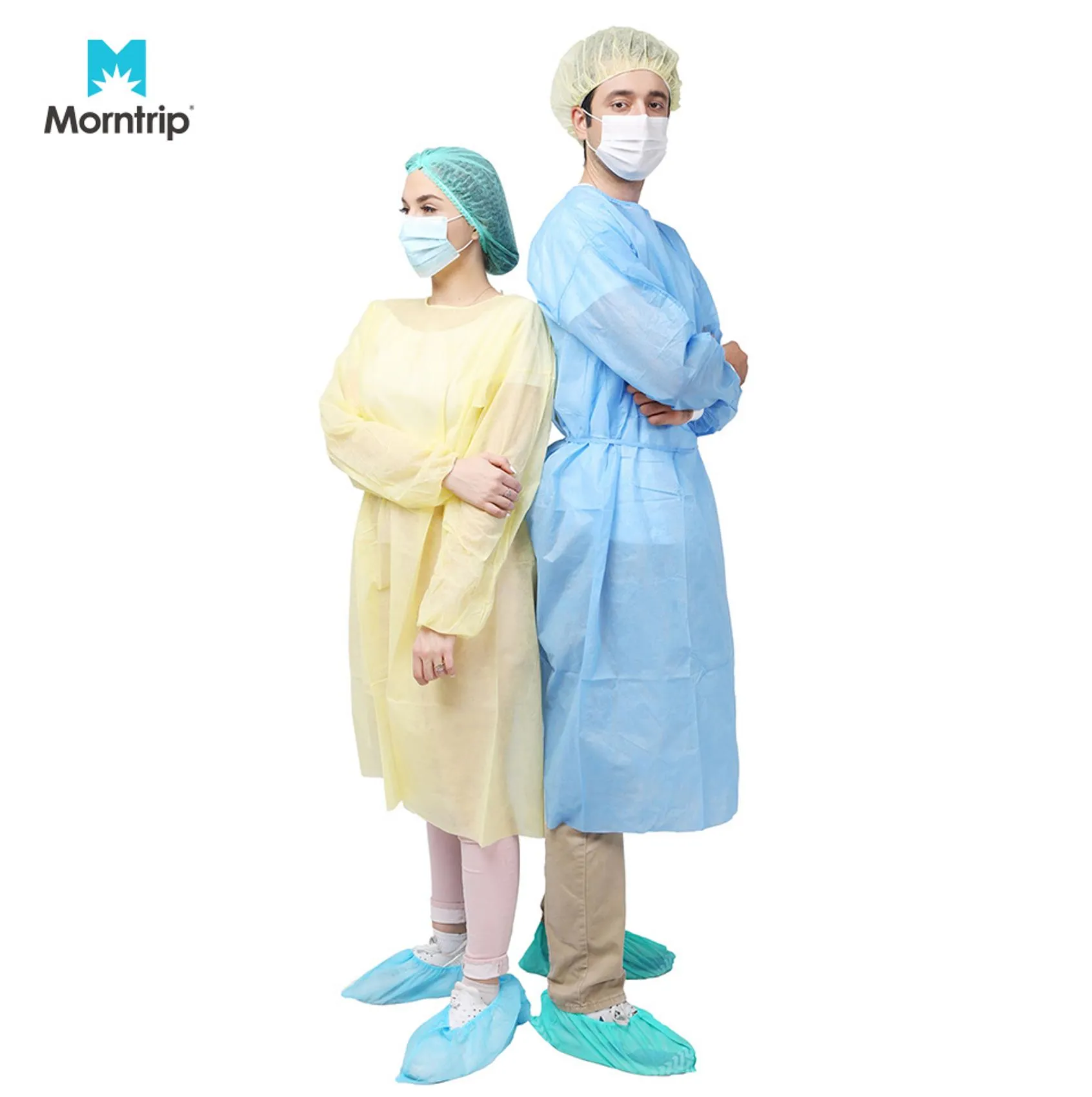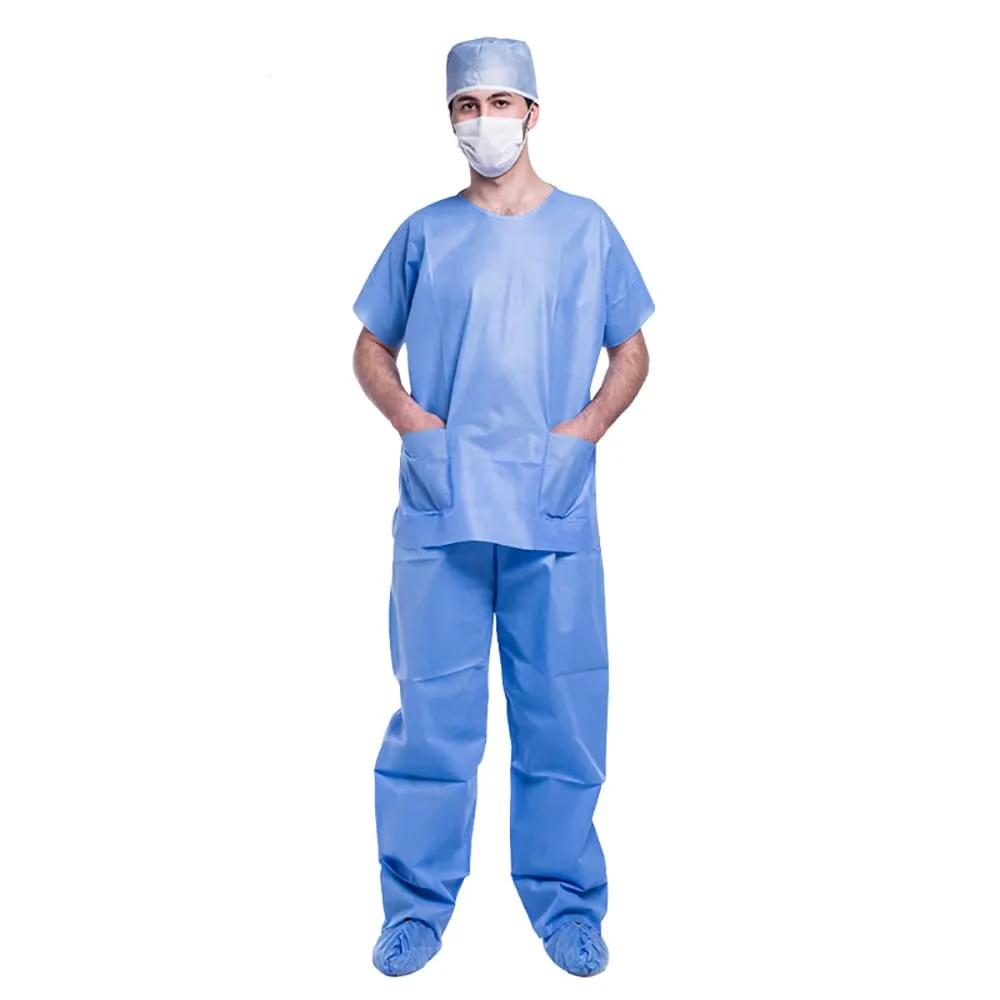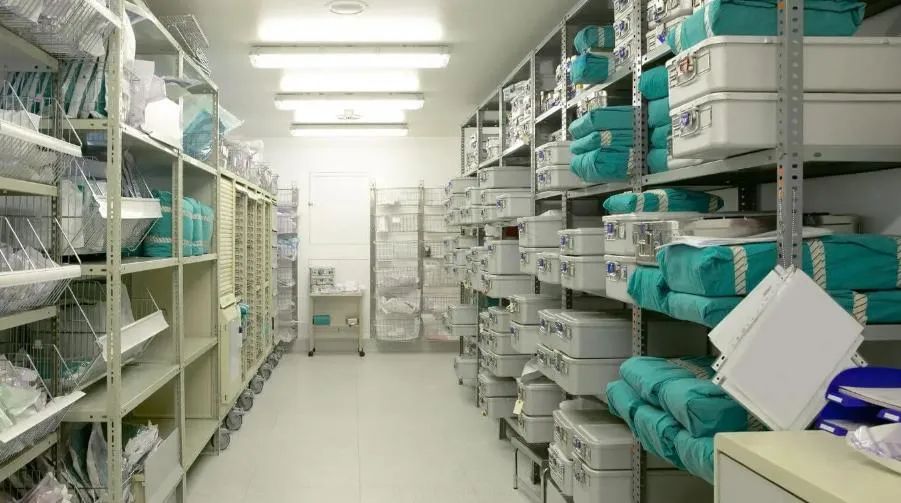Medical staff sometimes struggle with selecting the proper gown for daily care or surgery. Wearing the wrong type can make work harder and increase infection risk. That’s why knowing the correct option is essential. Here, I will walk you through the 4 Types of Medical Gowns and Their Uses, helping you make safer, smarter choices in the workplace.
4 Types of Medical Gowns
There are many types of medical gowns. Each one has a specific job and protection level. From my experience, understanding these types is key. It helps you choose the right gown for any task.
1. Isolation Gowns: Lightweight Protection for Routine Care
Isolation gowns offer lightweight protection for everyday care. They are made from polypropylene or SMS (spunbond-meltblown-spunbond) fabrics. These gowns resist fluids. I find them perfect for general patient contact. They work well in low-risk, non-sterile settings for simple procedures. These gowns are non-sterile. They are Class I medical devices, good for outpatient clinics or basic exams.
Key features:
– Provide ANSI/AAMI PB70 Level 1–2 protection
– FDA Class I classification
– Most are disposable and cost-effective, but some reusable options exist
– Used for routine care, patient exams, and as visitor gowns
– Offer a basic barrier against minimal fluid contact
2. Surgical Gowns: Sterile Barrier for High-Risk Procedures
Surgical gowns provide a sterile barrier during high-risk procedures. They use reinforced materials like polyester or PE-laminated blends. Protection is focused on the front and sleeves. I believe these gowns are vital in operating rooms. You need them for invasive procedures with a moderate to high risk of fluid contact.
Key features:
– Must meet FDA Class II standards and ANSI/AAMI PB70 Level 3 or 4
– Sterile and made to cover critical zones like the chest, abdomen, and arms
– May have breathable films that let moisture out but block fluids for more comfort
– Example: DYNJP2306P Prevention Plus sterile surgical gown, known for its reinforced films and high comfort
– Protection can reach up to 99.9% against blood-borne pathogens with Level 4 gowns
3. Chemotherapy Gowns: Maximum Barrier Against Hazardous Drugs
We make chemotherapy gowns to handle hazardous chemotherapy drugs. The fabric has a polyethylene coating or lamination. This makes them block cytotoxic fluids completely. They have closed backs, long sleeves, and tight cuffs for the best coverage.
Key features:
– Must meet ASTM F739 standards for resisting chemotherapy drug permeation
– Most are disposable, and I recommend single-use to lower exposure risk
– Used in oncology, pharmacies, and infusion centers
– Often yellow or have markings for quick identification
– Offer full-body coverage; I suggest wearing them with chemotherapy-tested gloves
– Barrier effectiveness is tested for breakthrough times with drugs like cisplatin, doxorubicin, and cyclophosphamide
4. Patient Gowns: Comfort and Access for Patients
I suggest medical patient gowns for comfort and modesty. They are great for exams and hospital stays. Most have an open-back design with ties or snaps. This design allows clinicians access while respecting the patient.
Key features:
– Made from light, breathable fabrics like cotton, poly-cotton blends, or tissue with multiple layers
– Styles include open-back, split-back for bedridden patients, snap-front, and front-wrapping
– Example: Graham Medical 222 three-layer tissue exam gown (30″ wide, 42″ long, under 9 lbs per 50-pack)
– Specialized gowns are available, such as oversized/bariatric, capes, and three-armhole types
– Standard features include waist ties up to 42 inches and many sizes to fit all patients
Comparison Table: Quick Reference for Medical Gown Selection
| Medical Gown Type | Use Case | Material/Design | Barrier Level | Key Features |
|---|---|---|---|---|
| Isolation gown | General patient care, low risk | Polypropylene or SMS | AAMI PB70 1–2 | Lightweight, fluid-resistant, non-sterile |
| Surgical gown | Surgery, moderate/high risk | Reinforced, sterile fabrics | AAMI PB70 3–4 | Sterile, strong sleeves, critical zone cover |
| Chemotherapy gown | Handling hazardous drugs | Poly-coated, impermeable | Chemo drug tested | Impervious, closed back, tight cuffs |
| Patient gown | Patient wear, comfort | Cotton, poly-cotton, tissue | Not rated (comfort) | Open/split back, ties/snaps, broad sizing |
Key Uses and Protective Roles of Medical Gowns in Healthcare
From my experience, medical gowns are key to preventing infections. They help keep healthcare environments sterile and safe. How well a gown works depends on a few things. I suggest you consider the gown type, its material, how waterproof it is, and if you’re using it correctly.
How Medical Gowns Prevent Infection
Using gowns lowers the risk of spreading germs during medical care. I’ve seen how effective this can be. For example:
In pediatric ICUs, I recommend using high-barrier gowns with gloves. This practice lowered hospital-acquired infections. It also helped stop the spread of respiratory syncytial virus (RSV). The results were even better with quick lab tests and dedicated nursing teams.
I believe gown rules are crucial for controlling superbugs like VRE. Staff should wear a gown before entering the room of any patient at risk.
Based on what I’ve read, when hospitals monitor staff, about 62–63% follow the rules for wearing gloves and gowns.
Infection Control Backed by Evidence
Disposable gowns are very popular. They make up at least 80% of the isolation gown market. I think this is because they are easy to use and you can throw them away after contact with germs.
In my opinion, using gowns and gloves for specific high-risk tasks is very effective. In long-term care, this approach cut S. aureus growth by 65%. It also reduced MRSA by 72%. The odds ratio for S. aureus was 0.35, and for MRSA, it was 0.28.
Keeping Surgical Areas Sterile
In the operating room, I suggest always using sterile medical gowns. They keep the surgical area clean. They also protect both the patient and the staff from spreading germs.
The FDA sees surgical gowns as Class II medical devices . This is because they are so important for keeping surgery sterile and preventing infection.
Rules require staff to wear these gowns during surgery. I believe this lowers the chance of wound infections and keeps the operating room cleaner.
Emergency Response and Extra Capacity
During an emergency like an infectious disease outbreak (e.g., COVID-19):
The need for isolation gowns skyrockets. I know this is to protect healthcare workers from unknown or very dangerous germs.
Disposable, full-body gowns that block fluids have become a necessity. In my experience, you need them for procedures that create airborne particles and have a high risk of exposure.
Daily Use in Clinics and Labs
For daily patient care and lab tasks:
We typically use non-sterile isolation gowns for routine exams and collecting samples. They help prevent germs from spreading between patients.
In labs, I often see staff using short-sleeved disposable gowns when they handle biological samples.
Practical Examples of Gown Application
Routine exams : Use of non-sterile isolation gowns.
Lab work : Short-sleeved disposable gowns.
Pandemic response : Fluid-resistant disposable gowns for all contacts.
Open surgery : Sterile, reinforced surgical gowns.
A Guide to Choosing the Right Medical Gown for Any Procedure
Choosing the best medical gown requires a clear process. Based on my experience, you need to match the gown’s protection level, standards, and supplier to the specific risks of your work.
How I Assess Risk and Protection Levels
Level 1 gowns:
I recommend these for basic care. Use them where you expect minimal fluid, like in minor biopsies or some eye procedures. A Level 1 gown often works well for cataract surgery.
Level 2 gowns:
I suggest these for procedures with low to moderate risk. Consider them for tonsillectomies, minor orthopedic cases, hernia repairs, or endoscopic GI work.
Level 3 gowns:
You will need these for longer or more invasive procedures with moderate risk. I choose them for tasks like open GI surgery or knee arthroscopy, where more fluids are expected.
Level 4 gowns:
These are essential for operations that enter the body cavity. This includes open abdominal surgery or major trauma care. A Level 4 gown provides a complete fluid-proof barrier across all critical zones.
| Gown Type | Best Used For | Risk Level | Barrier Level | Regulatory Class |
|---|---|---|---|---|
| Isolation Gown | Routine outpatient exams | Low | Level 1–2 | FDA Class I, Non-sterile |
| Surgical Gown | General surgery | Moderate–High | Level 3–4 | FDA Class II, Sterile |
| Surgical Isolation Gown | High-risk, high-fluid ops | High | Level 3–4 | FDA Class II, Sterile |
My Tip:
I recommend using non-surgical isolation gowns for routine care and exams. Do not use them for any surgical procedures.
My Method for Ensuring Compliance
FDA Classification: You must understand the FDA classes. Isolation gowns are Class I and do not require a premarket review. They are suitable for AAMI Levels 1-2. Surgical and surgical isolation gowns are different. They are Class II and need FDA 510(k) clearance, meeting Level 3 or 4 standards.
ANSI/AAMI PB70 Compliance: I believe this standard is critical. I always check the label and paperwork to confirm compliance when I purchase gowns.
Sterility: You must confirm if the procedure requires a sterile medical gown. It is a simple but vital check.
My Thoughts on Cost, Bulk Buying, and Quality
I suggest a risk-based approach when you stock medical gowns. This prevents you from wasting money on high-level gowns for low-risk situations.
For hospitals and clinics, I recommend buying Levels 1-2 in bulk. Purchase higher-level protection (Levels 3-4) as needed for specific procedures.
Durability is important. I ask for and review durability test results, such as grab and tear tests. Strong, tear-resistant synthetic materials can lower your long-term costs. They last longer and give better protection.
Bulk discounts: You can negotiate with medical gown suppliers for volume pricing. From my experience, you should never sacrifice compliance or safety for a lower cost.
How do I Evaluate Vendors and Medical Gown Samples?
- Check reviews and reliability:
I look at both user feedback and industry ratings to get a complete view of the vendor. - Test before you buy:
I suggest you ask for medical gown samples. This lets you evaluate the fit, comfort, and barrier protection in your own work environment. - Verify documentation:
I insist on seeing proof of FDA approval and AAMI PB70 test results. If sterility is required, ask for that certification too. - Lint performance:
Make sure your chosen medical gowns are low-lint or lint-free to avoid contaminating sterile areas during surgery. - Steady Supply:
Confirm the vendor can maintain a consistent inventory. This is vital if you need large or urgent orders.
Quick Reference Examples
| Procedure Type | Recommended Medical Gown Level |
|---|---|
| Cataract surgery (minimal fluid) | Level 1 gown |
| Hernia repair, minor GI endoscopy | Level 2 gown |
| Knee arthroscopy, open GI | Level 3 gown |
| Open abdomen/major trauma | Level 4 gown |
Best Practices for Medical Gown Care, Handling, and Disposal
I believe handling medical gowns correctly is essential. It’s vital for stopping infections, keeping staff safe, and protecting the environment. Here is my guide on washing, storing, disposing of, and training staff on how to use gowns.
Laundering and Maintenance of Reusable Medical Gowns
Based on my experience, you should follow CDC rules for reusable medical gowns. Wash them at 71°C (160°F) for 25 minutes with an industrial detergent. Do not use bleach. I suggest you use a souring agent before the final rinse and spin cycle.
Industrial dryers should run between 65–76°C for at least 30 minutes. This heat effectively kills germs. It also protects the gown’s polyester fibers from getting damaged.
I recommend inspecting medical gowns after the 1st, 25th, 50th, and 75th wash. Look for signs of wear, thin spots, or rips. If a gown fails this check, you must replace it. A strong, intact barrier is critical for safety.
You should only use certified laundry facilities that follow strict rules. From my perspective, improper washing can cause lasting damage, reducing the gown’s protective qualities.
Safe Disposal of Disposable Medical Gowns
You must throw away disposable medical gowns after a single use. I advise you never to try washing or reusing them.
Dispose of used gowns as regulated medical waste. This action stops the spread of contamination. In North America, these gowns create about 80% of all hospital gown waste.
I suggest you look into disposal choices that are better for the environment. Some polypropylene gowns can be recycled. Burning them to create energy also reduces landfill waste. A switch to reusable systems can cut hospital gown waste by over 70%.
Gown Storage: Keeping Clean and Used Medical Gowns Separate
I recommend storing gowns in a dry, clean place. Use covered carts or sealed packages. This protects clean gowns from exposure to the open environment.
Always keep clean and soiled gowns in completely separate areas. This simple practice prevents germs from transferring. It also ensures that the clean gowns provide a reliable barrier.
Staff Training and Protocol Compliance
I feel all staff members need the required training. They must learn the correct way to put on, take off, wash, check, and throw away gowns.
In my experience, facilities that conduct yearly skill checks and practice drills see better results. Using visual guides with clear steps helps reduce handling mistakes.
Incorrect gown handling is connected to about 40% of PPE failures. This problem gets much worse during pandemic surges. I believe continuous education is essential to lower this risk.
The Future of Medical Gowns: Smart Tech, Eco-Friendly Materials, and New Rules
From my experience, smart technology and green materials are changing the medical gown industry. Based on what I’ve seen in 2025, the newest medical gowns do much more than just control infections. I want to show you the key advances that come from the latest market trends, new tech, and changing global standards.
Smart Gowns: Built-In Sensors and Health Data
I’ve seen many new PPE medical gowns with antimicrobial coatings. They use materials like silver nanoparticles to stop bacteria and virus growth. Beyond that, the most advanced designs use fabrics with sensors to track a patient’s vitals in real time, such as:
- Heart rate
- Temperature
- Respiration
- Blood pressure
These sensors send data to clinicians, which I find is a huge help in intensive care, remote patient monitoring, and telemedicine. My favorite examples include:
- ECG sensors woven directly into the gown fabric
- Non-invasive glucose and hydration monitors for ongoing care
- AI tools that analyze gown data to send predictive alerts or health advice
Some smart medical gowns can even manage temperature, pull moisture from the skin, and help prevent pressure sores for patients who are in bed for a long time. These features are making hospital gowns more common in both clinics and homes. In fact, 60% of new gown contracts in 2025 require them to be suitable for home care.
Sustainability: Gowns that are Biodegradable, Recycled, and Reused
Hospitals produce about 160,000 tons of medical fabric waste every year. To fix this, I see medical gown manufacturers making new gowns from bioplastics, recycled PET, and natural fibers. They are also promoting a circular system, which includes:
- Reusable multi-wash gowns
are built to last through many washing cycles - Take-back programs and recycling partnerships with hospitals, with strong programs in Europe and Asia
Industry leaders aim to cut fabric waste and carbon emissions by 40% over five years in major hospital networks. More hospitals are adopting circular contracts, which ensure gowns are properly cleaned, sterilized, and sent back out for use.
I recommend looking at these product examples:
– 3D-knitted gowns that fit a patient’s size, with built-in sensors and antimicrobial layers. I think these are perfect for pediatric ICUs.
– Self-cleaning, liquid-repellent coatings that make gowns last longer and reduce the need for laundering.
– Gowns created for both hospital and home settings, which I like because they have flexible closures and give patients more privacy.
Regulatory Trends: New Standards for the Next Wave of Gowns
Global agencies like the WHO and FDA are updating their rules to include these new medical gown features. Based on my analysis, here are the key regulations I expect to see:
Tighter definitions for what counts as a germ barrier and more detailed tests for how well antimicrobial coatings work.
Potential new requirements for digital tracking of PPE, including:
- Recorded life-cycle reports.
- A unique device ID for each tech-enabled and green gown.
By 2028, I predict that at least 30% of medical gowns in developed markets will have to meet these new standards for electronic records and performance.
Market Outlook and Demand
In Saudi Arabia, the hospital gown market is expected to grow from USD 135.1 million in 2024 to USD 237.95 million by 2030. I believe this growth comes from the quick adoption of smart and sustainable gowns.
Around the world, comfortable and multi-use gown designs are now standard. This is a direct result of the lessons from the COVID-19 pandemic.



 (1).jpg)

